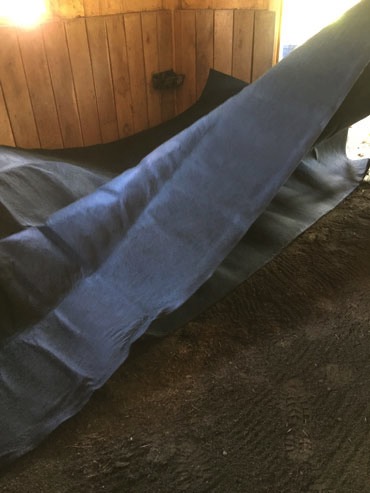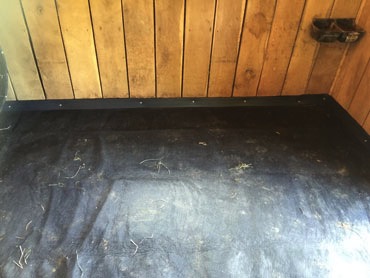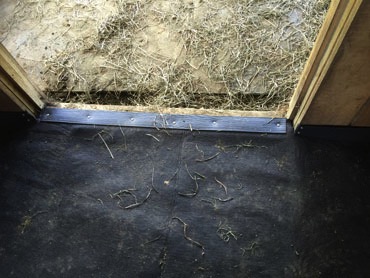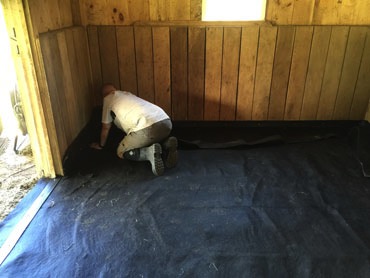Stall Flooring
When we first built the barn we decided to start with four 12x12 stalls (two for the females, two for the males) with a removable wall between the two 12x12 stalls in the event we wanted to have a 12x24 stall. Outside of those stalls, we have overhangs on each side that are 12 foot by 24 foot wide where the alpacas can escape the sun and snack at the hay feeders. We envisioned that the alpacas would drag hay around their stalls at least, but we didn’t feel there was much need to worry about excessive material loss from raking/cleaning the stalls since we didn’t think they would go to the bathroom in their cozy stall home. What we didn’t account for, however, was how much the alpacas would want to stay in their stalls and not venture out very far anytime there was rain, snow, windy cold days, or some exciting mini-series on Animal Planet (no, they don’t really have TV installed in the barn… yet!). This realization, which came after our first winter, had us thinking about what sort of base material we needed in the stalls to allow for proper drainage, yet also allow for easy cleanup without much material loss.
Outside of the barn, under the overhangs, we expected that might experience some erosion/washout, given that we built the barn on a sloping hill. Therefore, we found what seemed to be the perfect product called Equiterr that was being used at another local farm, and this solution would provide some base structure and prevent rivers of water from heavy rains taking our stone down the hill with it. We put several inches of larger rocks under the Equiterr squares and then topped it off with stone dust. We felt very proud and excited about our engineered flooring! Then we brought the animals to the farm and quickly learned how our initial logic was flawed…
Animal husbandry is a science experiment on a grand scale with many variables involved, as we have found raising alpacas with four very diverse seasons in Virginia. Alpacas tend to stay in the barn a lot more than we expected, this is especially true when it is hot and humid in the summer, and when it is cold and windy in the winter. While they always seem to venture out at night (especially the girls with their guard llama escort, Gabe), they do spend a lot of time around the barn and aren’t going to pick an easy to clean area for their communal manure pile, despite what some of the alpaca propaganda led us to believe. Therefore, we found that regardless of the season, there were always bean piles near the barn, if not in the stables, particularly when they need the shelter or the comfort of the fans. We found that we were losing a lot of crushed stone material and needed to replace it at least quarterly. It is easy to replace the crushed stone under the overhangs of the barn, but getting in to the stalls with the front loader is next to impossible. Further, stone dust that is left in a pile outside (like ours was) becomes quite compact. A shovel of it alone is back-breaking, given how much moisture it holds, but we really needed at least a good 10 cubic feet of it, which weighs somewhere close to what a front porch would weigh, and when in a wheelbarrow, it’s near impossible to move with any grade in the land. We realized we needed a better solution in the stalls, because managing the stone dust loss from daily mucking was overwhelming.
At first we tried some 8x8 show mats, but we found even those were a pain to rake and worse off after a few months they smelled terrible and power washing them was not effective, as it ruined their structural integrity.
We eventually found a product, after a lot of reading and searching on the Internet, that some folks with horses were using called Stall Skins. We bought one to test out and despite the initial effort to put them in, circa 2 hours per 12x12 stall, we found they were very effective and eliminated our base material loss. If you are interested in understanding exactly how they are designed, you can visit their site above; I won’t go into laborious detail here. The bottom line is that they make mucking the stalls quite easy. They look nice, control the drainage well, and further the Stallskins can be powerwashed without destroying the integrity of the fabric – and of course in-between thorough cleanings, a little bit of Sweet PDZ covers up any urine odor. We’re fans of the StallSkins. We ended up getting them for our other 3 stalls and are quite pleased with them.
As with nearly everything we’ve done since we started our farm, this was quite a learning experience. Looking back at it now it was a good learning opportunity that took some trial and error to solve. We have a bit of a unique landscape on our property but that aside, keeping stalls clean and manageable is a challenge for most people with animals living in a barn. If you’re having a similar issue or have any questions about this post, please reach out and we’re happy to share stories and insight to help you avoid making any of the mistakes we’ve made along the way.





